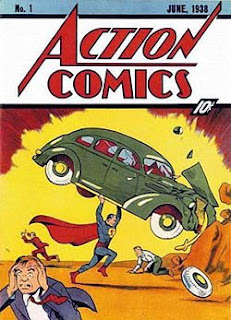 By now, most everyone has heard that great story (possibly apocryphyal) of that guy who went rooting through his grandfather's or his father's old stuff in the attic and while riffling through a box that hadn't seen the light of day in 40 years-discovers a copy of the oh-so-rare and VALUABLE comic book-Action Comics #1 (first appearance of Superman)!!!!
By now, most everyone has heard that great story (possibly apocryphyal) of that guy who went rooting through his grandfather's or his father's old stuff in the attic and while riffling through a box that hadn't seen the light of day in 40 years-discovers a copy of the oh-so-rare and VALUABLE comic book-Action Comics #1 (first appearance of Superman)!!!!Natural history museums have their "Action Comics #1" stories as well!!
 Our story begins over 30 years ago or so with famous echinoderm biologist H.B. "Barry" Fell (an awesome bio is here.) who for various reasons shifted his research from echinoderm systematics to Maori languages in the early 70s.
Our story begins over 30 years ago or so with famous echinoderm biologist H.B. "Barry" Fell (an awesome bio is here.) who for various reasons shifted his research from echinoderm systematics to Maori languages in the early 70s.As a consequence, many of the echinoderm specimens in his care were inherited by a PhD student, who got his degree but ultimately had to leave systematics-as the 70s-80s were not a great time, jobwise, to be an echinoderm biologist and so the student did what he could: he placed the specimens into deep-storage.
 The student continued his research where he could-but ultimately was motivated to deposit/return the collection to Barry Fell's most prominent student in North America-David Pawson, curator of Echinodermata at the Smithsonian.
The student continued his research where he could-but ultimately was motivated to deposit/return the collection to Barry Fell's most prominent student in North America-David Pawson, curator of Echinodermata at the Smithsonian.
 That student returned over 500 lots of ophiuroids, starfish, crinoids, and sea urchins which had been "out of circulation" for over 30 years!
That student returned over 500 lots of ophiuroids, starfish, crinoids, and sea urchins which had been "out of circulation" for over 30 years! After these boxes arrived, I began pecking through them to check for proper identifications and to begin specimen curation, so that specimens which looked like this
 Could be re-housed and stored in snazzy, clean and protective archival plastic bags or boxes like this one:
Could be re-housed and stored in snazzy, clean and protective archival plastic bags or boxes like this one:
 Along the way, I found a bunch of echinoderms stored in these AWESOME antique style boxes:
Along the way, I found a bunch of echinoderms stored in these AWESOME antique style boxes:

 But what was REALLY amazing? Discovering specimens that had these tags:
But what was REALLY amazing? Discovering specimens that had these tags:
 It turns out that these (and several other lots) were LOST type specimens!!!
It turns out that these (and several other lots) were LOST type specimens!!! What are type specimens??? Type specimens are the original specimens on which the description of any species is based. The type specimens are those which are used to describe a new species in the original manuscript. Typically, these specimens are housed in museums under lock and key. It is these specimens that the "identity" of any given species is tied to (unless the species is particularly well-known).
Concepts of economically important or otherwise ecologically important species can be tied up based on the concepts expressed by these specimens. One can draw an immediate parallel with Action Comics #1. Think of type specimens as the early issues of a superhero appearance!! The "first issue" is the first relevant appearance of that species:
- *It sets up the look (i.e., the morphological or physical description)
- *The story (i.e., what the author intended for the species to look like)
- *And sets up other accessory characters or story elements (i.e., other related species, comparisons, etc.).
 Sadly, (or perhaps fortunately) type specimens seldom if ever carry an actual cash value.
But they are VITAL parts of the taxonomic museum landscape because fundamentally, you can't do anthing in systematics or ecology without the foundation established by these specimens.
Sadly, (or perhaps fortunately) type specimens seldom if ever carry an actual cash value.
But they are VITAL parts of the taxonomic museum landscape because fundamentally, you can't do anthing in systematics or ecology without the foundation established by these specimens.Nothing feels better than a good afternoon going through a box of dusty old specimens, going through some history...and discovering some...great historical treasure right in your hands! Action Comics #1? Or paratypes for Pseudechinaster rubens?? Either way....a good day.
2 comments:
Finding lost type specimens definitely woould be nice.
I'm glad you enjoy your work so much!
Post a Comment